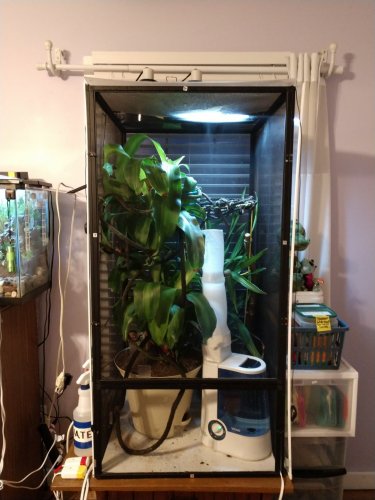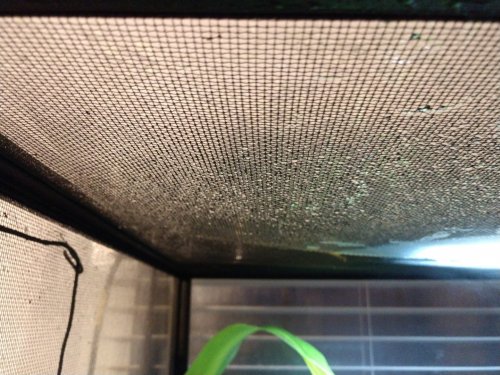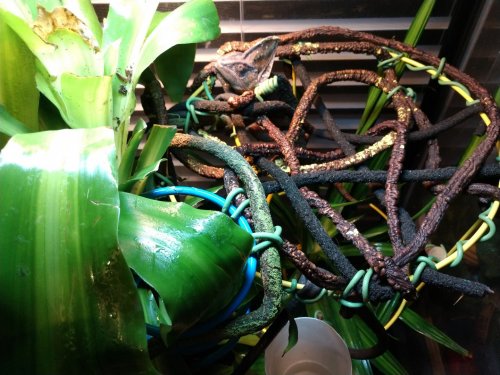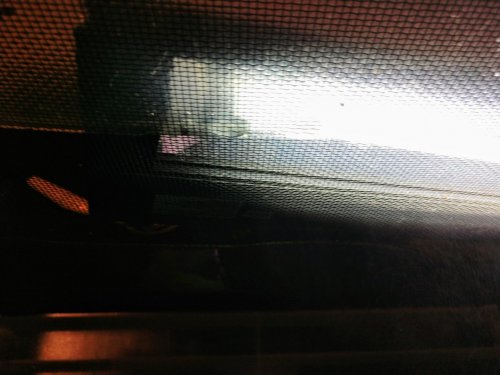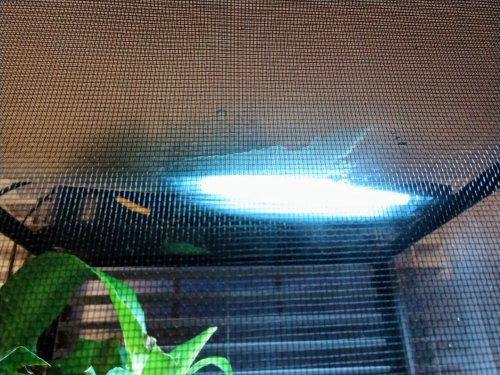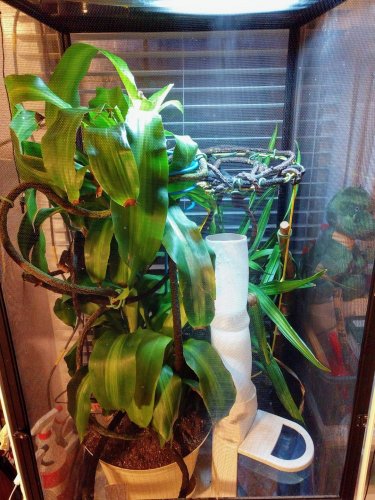Hannah1966
Member
WHAT THE HECK IS THIS?!!
HE DIDN'T HAVE A BRIGHT YELLOW SMUDGE ON HIS HEAD LAST NIGHT!
I actually tried wiping it off with a very soft cloth and water to no avail.. I think Golda the Leopard Gecko tagged him with a teeny tiny can of bright yellow spray paint in the middle of the night while he slept. At least I hope that's what happened! If she didn't do it then one of the birds did it and if they didn't do it, it was a fish. You know those GloFish can get a little kra-kra when the lights go out!
BUT SERIOUSLY... THE FACTS ARE:
The "bright yellow smudge" just appeared this morning. The room he is in stays at 80 degrees and about 80% humidity because of the heat emitters and the humidifiers.
Yes he finished shedding about 3 days ago.
And yes he does like his mercury vapor bulb, it is on 10-12 hours in the daytime.. and the ceramic heat emitter is on at night. But he is about 6-8" away from it at least.
I took him to the vet about 10 days ago right after PUFF passed away and we did fecal tests blood work and nothing came back as something to worry about. (Insert sigh of relief here.)
I told the doctor that even as a very young juvie when I got him as a rescue critter, either he has been dehydrated all his life or genetically he is predisposed to having slightly sunken eyes.
To test that theory I am giving him SQ fluids, 12cc Norm-R with vitamin B, everyday for 14 days. It is day 10, and he still continues to act/eat/drink?/poop & urates all normal and his eyes still look as sunken in as the day I rescued him.
Back to the bright yellow smudge on the top of his casque...
When he is in a good mood and happy the surrounding colors incorporate that same bright yellow smudge pigment. But when he is not happy and his colors go dark, that bright yellow smudge is still there on the right side and it crosses over the front ridge of the casque and just barely to the left side as well.
PHOTOS:
All photos were taken today. The first three show SPIKE'S "bright yellow smudge." The last one shows SPIKE'S "happy colors" and the smudge seems to disappear in the "happy pigment."
All questions welcome, but true, correct answers & advice are more welcome!
Blessings and SHALOM!!




HE DIDN'T HAVE A BRIGHT YELLOW SMUDGE ON HIS HEAD LAST NIGHT!
I actually tried wiping it off with a very soft cloth and water to no avail.. I think Golda the Leopard Gecko tagged him with a teeny tiny can of bright yellow spray paint in the middle of the night while he slept. At least I hope that's what happened! If she didn't do it then one of the birds did it and if they didn't do it, it was a fish. You know those GloFish can get a little kra-kra when the lights go out!
BUT SERIOUSLY... THE FACTS ARE:
The "bright yellow smudge" just appeared this morning. The room he is in stays at 80 degrees and about 80% humidity because of the heat emitters and the humidifiers.
Yes he finished shedding about 3 days ago.
And yes he does like his mercury vapor bulb, it is on 10-12 hours in the daytime.. and the ceramic heat emitter is on at night. But he is about 6-8" away from it at least.
I took him to the vet about 10 days ago right after PUFF passed away and we did fecal tests blood work and nothing came back as something to worry about. (Insert sigh of relief here.)
I told the doctor that even as a very young juvie when I got him as a rescue critter, either he has been dehydrated all his life or genetically he is predisposed to having slightly sunken eyes.
To test that theory I am giving him SQ fluids, 12cc Norm-R with vitamin B, everyday for 14 days. It is day 10, and he still continues to act/eat/drink?/poop & urates all normal and his eyes still look as sunken in as the day I rescued him.
Back to the bright yellow smudge on the top of his casque...
When he is in a good mood and happy the surrounding colors incorporate that same bright yellow smudge pigment. But when he is not happy and his colors go dark, that bright yellow smudge is still there on the right side and it crosses over the front ridge of the casque and just barely to the left side as well.
PHOTOS:
All photos were taken today. The first three show SPIKE'S "bright yellow smudge." The last one shows SPIKE'S "happy colors" and the smudge seems to disappear in the "happy pigment."
All questions welcome, but true, correct answers & advice are more welcome!
Blessings and SHALOM!!


